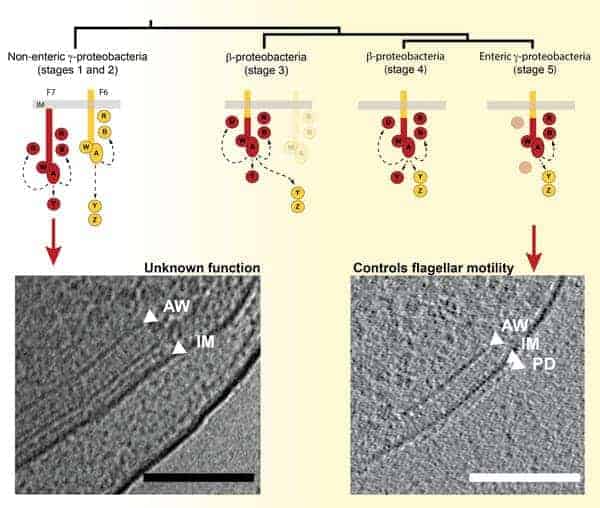Caltech researchers and collaborators have discovered how the bacteria Escherichia coli evolutionarily repurposed cellular machinery into a kind of navigation system to control movement through its environment.
The study was led by researchers in the laboratory of Grant Jensen, professor of biophysics and biology and Howard Hughes Medical Institute Investigator. A paper describing the research appeared in the journal Nature Communications on April 27.
Much like you might follow your nose toward delicious odors—or away from bad smells—bacteria sense chemicals in their environments and move around accordingly using rotating tails called flagella. This process of detecting an external chemical signal and taking steps to move correspondingly is called chemotaxis.
“The chemotaxis system sniffs for chemical cues in the environment and guides the bacteria toward beneficial places and away from harmful ones,” says postdoctoral scholar Davi Ortega, first author on the new research. “Some consider this system as the ‘brain’ of the bacteria as it is a relatively simple and yet sophisticated mechanism for decision making—it tells the bacteria where to go. It does that by considering a multitude of different chemical cues, integrating the information, and comparing the current state of the environment with how it was a few moments ago.”
Chemotaxis is an example of a chemosensory pathway. There are 19 different types of chemosensory pathways known in bacteria, though not all control motility. Each pathway is made up of different subsets of chemosensory proteins and form independent macromolecules.
The chemosensory system in E. coli was previously studied, but in this new study, researchers looked at the molecular machinery making up chemosensory pathways in other bacteria of the same class, using a technique called cryo-electron microscopy. They imaged four organisms, Vibrio cholerae (the bacterium that causes cholera), Pseudomonas aeruginosa, Shewanella oneidensis, and Methylomicrobium alcaliphilum, and found two chemosensory systems that were present in all of the bacteria. The systems assemble in distinct structures. One of the systems is known to control flagellar motility, but the function of the other remains a mystery; it only appears in a bacterium when the organism is starving.
Using comparative genomics and phylogenetic analysis, the researchers found that, for still unknown reasons, the chemosensory pathway controlling the flagellar motor in Pseudomonas and Vibrio is different than the one used in E. coli. The system with unknown function later evolved into the chemotaxis system in E. coli, the team found.
“We found that changing the input and output of chemosensory systems can change their biological roles in the cell,” says Ortega. “We show how nature repurposed a complex chemosensory machine to perform a different biological function by making relatively straightforward changes. This work makes chemosensory systems viable candidates to control different cellular functions in the future. For a speculative example, we may one day be able to develop bioengineered bacterial robots, controlled by adaptable chemosensory pathways, that can work as drug delivery systems.”
The paper is titled “Repurposing a chemosensory macromolecular machine.” Additional co-authors include Wen Yang and Ariane Briegel of Leiden University in the Netherlands; former Caltech postdoctoral scholar Poorna Subramanian; Petra Mann and Simon Ringgaard of the Max Planck Institute for Terrestrial Microbiology in Germany; former Caltech visiting student Andreas Kjær, now of Oxford University; Caltech research scientist Songye Chen (PhD ’07), co-facility director of the Beckman Institute Resource Center for Cryo-EM; Kylie Watts of Loma Linda University; Sahand Pirbadian of the University of Southern California; David Collins and Marina Kalyuzhnaya of San Diego State University; and Romain Kooger of Eidgenössische Technische Hochschule Zürich.
If our reporting has informed or inspired you, please consider making a donation. Every contribution, no matter the size, empowers us to continue delivering accurate, engaging, and trustworthy science and medical news. Independent journalism requires time, effort, and resources—your support ensures we can keep uncovering the stories that matter most to you.
Join us in making knowledge accessible and impactful. Thank you for standing with us!

